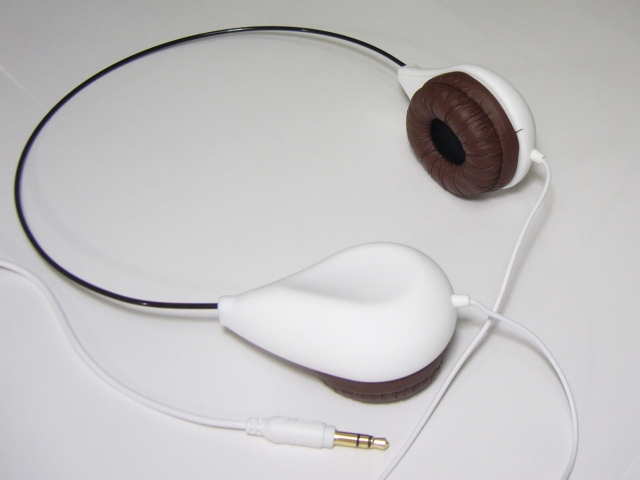Brief: Earquake’s striking take on the ‘AirFit” design pioneered by the Audio-Technica ATH-ON3
MSRP: $24 (discontinued)
Current Price: N/A
Build Quality (6/10): As with the aging ATH-ON3, the PIXI is built around the one-piece metal headband. The headband takes the form of a sturdy metal tube and retracts partially into the cups, which can also fold flat once fully retracted. This presents a small usability issue as the headband settings are lost whenever the headphones are stored away. Luckily, the headband is notched and finding the right fit again is usually quite easy. The cups on my (white) PIXI are made out of plastic but heavily rubberized, making them quite pleasant to the touch and seemingly durable (although the purple version is the one to buy for looks). The rubberized cable is quite similar to those use by Earsquake’s IEMs. It is thin but resists tangling well and has proper strain relief. An inline volume control is present partway down the cord, though the pod feels flimsy.
Comfort (4.5/10): The fit of the PIXI is very similar to that of the ATH-ON3 – the cups are parallel to each other when the headband is extended and there is little flexibility to the structure. As a result, the cups do not conform well to my ears no matter what I do. The clamping force of the headband is a bit lower than with the ATH-ON3, making it possible to wear them comfortably for more than an hour at a time. They still need adjusting from time to time, and the tiny cups with thick pleather pads make it especially important to position them on the ears properly for optimal sound quality.
Isolation (5.5/10): Isolation is quite decent for a tiny portable – the PIXI does cut down on leakage very well and even manages to attenuate a small amount of outside noise when they seal properly.
Sound (4.5/10): Like the Audio-Technica ON3 and Philips SHL1600, the Earsquake PIXI requires a good seal to sound its best. For me this meant that I had to hold the headphones to my ears for some of my listening but of course YMMV. Without a proper seal, the PIXI sounds shrill and distant – unpleasant to say the least. With the right fit, however, the headphones fill out nicely, offering up their intended sound signature. The bass is by far the best part of the sound signature – deep, full-bodied, and surprisingly impactful for a headphone as small as the PIXI. The low end is not the most accurate I’ve heard but certainly provides one of the more visceral experiences in the price range without sounding uncontrolled. The midrange is in good balance with the low end – perhaps even a bit forward – but lacks crispness and refinement. There is some unevenness and vocals can sound just a touch shrill at times. For a $25 headphone, however, it’s all well and good as far as I am concerned. The treble, too, is a bit grainy and can be harsh at times but it is prominent and extension is decent. With a poor seal the harshness is heavily exaggerated but with a proper fit the treble, bass, and midrange all stay fairly balanced.
My only major gripe with the PIXI is the presentation, which is quite two-dimensional. Next to the admittedly pricier Maxell DHP-II, the PIXI sounds flat and seems severely lacking in depth. Instrumental separation and layering are nearly non-existent with the PIXI. Tonally, the headphones are slightly warm due to the deep and resounding low end but the prominent treble prevents them from becoming dark and muddy bass canons a-la Philips SHL1600. The small soundstage, hard-hitting bass, and aggressive treble make the PIXI sound like a low-budget version of the Sennheiser HD25-1. Of course the HD25-1 works because it carries detail and clarity that put most other headphones to shame while the PIXI doesn’t. Still, as far as ‘AirFIt’-style headphones go, the PIXI is easily the best I’ve heard.
Value (6/10): The Earsquake PIXI is yet another small portable headphone that pursues fashionable aesthetics and a minimalistic form factor in lieu of comfort and isolation. The PIXI did surprise me with the excellent finish – the rubberized earcups on my pair are very pleasant to the touch and Earsquake uses a special curing technique to make sure that the paint on the blue and purple models doesn’t chip or crack over time. To make sure that the headphones don’t get scratched up when stored away, a soft cotton protective pouch is included as well. From a functionality standpoint, the PIXI are fairly stable once fitted properly but may require a bit of fiddling for the best sound. Comfort, while better than that of the aging ATH-ON3, is still typical of a small and fairly rigid headphone. The sound quality is slightly above average in the price range, impressing with clarity, balance, and bass depth but not with the harshness and lack of soundstage depth – nothing atrocious but I don’t think the Koss KSC75 has much to worry about as head-fi’s favorite budget set. For those thinking of picking up an ATH-ON3 or one of other fashionista ultraportables, I highly recommend grabbing the PIXI instead.
Manufacturer Specs:
Frequency Response: 20 – 20,000 Hz
Impedance: 16 Ω
Sensitivity: N/A
Cord: 4.26ft (1.3m); Straight Plug
Space-Saving Mechanism: Flat-folding

Earsquake PIXI Review
SHARE.
ABOUT AUTHOR
ljokerl
Living in the fast-paced city of Los Angeles, ljokerl has been using portable audio gear to deal with lengthy commutes for the better part of a decade. He spends much of his time listening to music and occasionally writes portable audio reviews across several enthusiast sites, focusing mostly on in-ear earphones.


